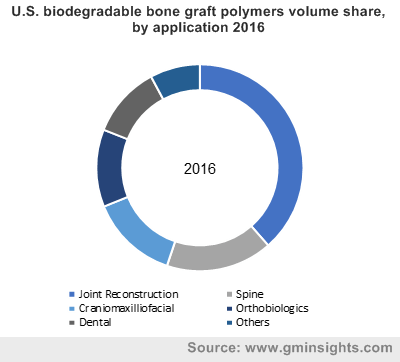Biodegradable bone graft polymers market to witness phenomenal returns over 2016-2024, product innovations to outline the strategic landscape
Publisher : Fractovia | Published Date : 2017-12-28Request Sample
Biodegradable Bone Graft Polymers Market is one amongst the few remunerative business spaces, where technology and innovation aptly outline the key to profitability and opportunities. The industry is profoundly carving an evolution tale from conventional allogeneic and autologous bone grafting techniques to synthetic bone grafts, primarily on account of the biodegradability and biocompatibility properties of the latter. Synthetic bone graft polymers are capable of mimicking efficiently the mechanical and physical nature of native tissue, which promotes osteoconduction for bone reconstruction. Add to it, these biodegradable polymers are capable of releasing drugs or growth factors in a spatial manner, a factor that has led to its extensive deployment in the designing of biomimetic scaffold for bone regeneration. Having come a long way since its inception, biodegradable bone graft polymers industry now boasts of providing innovative and effective medical solutions, that were claimed to remain absent for so long in the orthopedic space.
U.S. biodegradable bone graft polymers volume share, by application 2016

The incessant research efforts undertaken by biodegradable bone graft polymers market giants to bring synthetic bone grafting on the forefront basically stems from the fact that traditional bone grafting techniques still represent an array of daunting challenges for reconstructive surgery. Recently, researchers of Mayo Clinic College of Medicine and Science have come with a groundbreaking biodegradable spongy bone graft polymer, that allegedly expands to fill the gap in the spinal column. Reportedly, this absolutely state-of-the-art sponge-like implant made from hydrogel, allows the surgeon to transplant it just like any other titanium rods. As affirmed by the experts, after the injection the graft would be anchored securely with adjacent bone tissue growth on it. Big shots involved in biodegradable bone graft polymers industry have been already raving about the technology, claiming it to be a disruptive trend for the overall business space.
How biodegradable bone graft polymers market are making a profound headway in bone tissue engineering has been a subject of debate for healthcare giants since for a while now. Thriving in an era, where bone disorders are getting more pronounced day by day, biodegradable bone graft polymers industry is set to gain substantial momentum, without experiencing turbulent competition from rival spheres. According to few of the trusted reports, the occurrence of bone diseases is expected to double within the next five years, especially with the growing obese population. In this regard, North America witnesses an upper hand in the overall biodegradable bone graft polymers market share, with the United States covering a major chunk. Statistics depict, in 2016, nearly one million Americans had undergone hip and knee replacement. In fact, as claimed by the American Academy of Orthopaedic Surgeons, approximately 50% of the American adults suffer from knee osteoarthritis once in their lifetime. This astoundingly mammoth prevalence of joint replacement cases has thus prompted clinicians to come with alternative solutions that are comparatively more effective and outcome based, making the ground lucrative for biodegradable bone graft polymers market.
With robust technological interventions in biomedical engineering, the commercialization of the overall business space has ascended exceptionally. Say, for instance, 3D printing technology is the latest disruption that is aptly bringing a renewed dimension to joint reconstruction surgeries, which by extension is opening up new opportunities for biodegradable bone graft polymers industry. Experts claim, biodegradable bone graft substitutes that are manufactured using 3D printing technology allows fabrication of free form scaffolds that are ideal for tissue regeneration. Perhaps marred by the fact that 3D printing technology based polymers encompass hi-tech architecture, suitable pore size and additives of inorganic/ organic compositions, 3D printing based biodegradable bone graft polymers market is anticipated to witness remarkable proceeds both from vascularization and bone tissue regrowth applications.
Speaking of the competitive landscape, biodegradable bone graft polymers market boasts of the participation of some of the renowned companies including the likes of Corbion N.V., PolySciences Inc, Evonik, Foster Corporation, and KLS Martin. These giants have been readily engaging in R&D and product development in a bid to introduce advanced copolymer materials for bone graft and implant applications. While the strategic landscape is claimed to be fragmented as of now, the business space, in all likeliness, would become a bit consolidated over the coming years with the influx of big players from the APAC belt. In effect, the participation by these new enterprises would help the manufacturers to deal with the challenges even in the face of volatile economy, ensuring a steady pace of growth for the entire biodegradable bone graft polymers marketplace. Estimates claimed by Global Market Insights, Inc. depicts the global biodegradable bone graft polymers industry to surpass USD 690 million by 2024, in terms of commercialization.